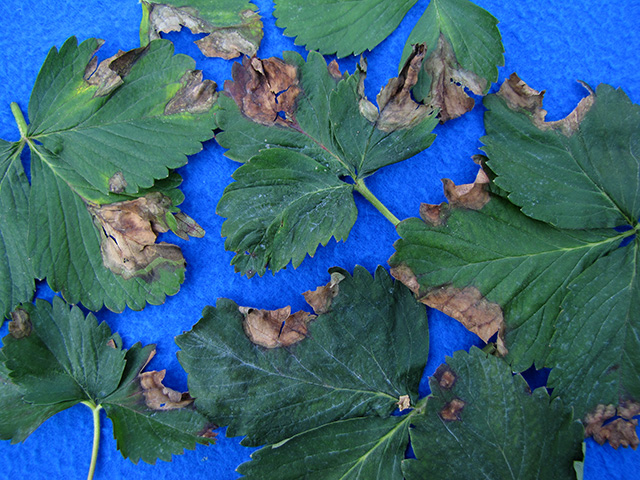This fungal disease has been observed affecting leaves on Long Island from mid-May to early June. Yield can be reduced directly because the pathogen can also infect fruit under warm conditions and indirectly next year because loss of leaves to this disease can weaken plants. The tiny black structures in the brown tissue in the last 3 photographs of leaves below are the fruiting structures (pycnidia) produced by this pathogen. Pycnidiospores produced in these structures are dispersed by splashing water. Fruit rot can also occur.
Management practices include planting certified disease-free plants of less susceptible varieties, removing old infected leaves which is where the pathogen survives over winter, planting where there is good soil drainage and air circulation to minimize leaf wetness, controlling weeds, and applying fungicides. Apply Rally (same active ingredient is in Agristar Sonoma) or Mettle (these are all FRAC code 3) in alternation with Rendition and Topsin-M. Apply these (except Rendition) with copper fungicides for resistance management. To achieve effective control applications need to be started well before symptoms are seen because there is a long period between infection and visible symptoms. Infection can occur early in the growing season and symptoms not appear until during or after harvest.
Please Note: The specific directions on pesticide labels must be adhered to — they supersede these recommendations if there is a conflict. Any reference to commercial products, trade or brand names is for information only; no endorsement is intended. For up-to-date information on labeled fungicides see Cornell Pest Management Guidelines for Berry Crops.
Updated June 2018.
Leaves below were photographed on 31 May 2017 fresh from the field. Leaf spots enlarged and pycnidia developed while the leaves were incubated on wet paper towel in a ziplock bag. The second image is the leaf in the upper left corner of the first image on 6 June.
Tiny round black structures in the following photographs are pycnidia. They have formed in older, necrotic diseased tissue and are diagnostic for Phomopsis leaf blight.
Pycnidia can also form on petioles as shown below.
Occasionally pycnidia form in the center of a fruit rot spot. They are present in the center of the second image below. Observing pycnidia confirms the rot is due to Phomopsis and not anthracnose.
For additional information and photographs see NC State Extension web page.













